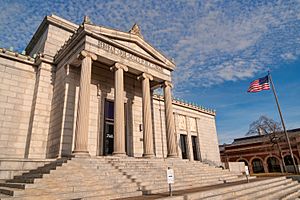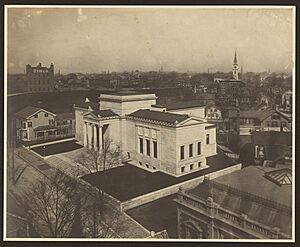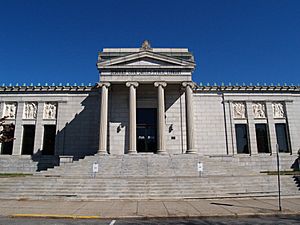Pawtucket Public Library facts for kids
Quick facts for kids Pawtucket Public Library |
|
|---|---|
 |
|
| Type | Public library |
| Established | 1852 |
| Location | 13 Summer Street, Pawtucket, Rhode Island |
The Pawtucket Public Library is a cool place in Pawtucket, Rhode Island. It's located at 13 Summer Street. The main building was a gift to the city from its first mayor, Frederic Clark Sayles. He gave it in memory of his wife, Deborah Cook Sayles. That's why it was once called the Deborah Cook Sayles Public Library. Later, the library grew and connected to the old Pawtucket Post Office building. This old post office is now called the Gerald S. Burns Building.
Contents
A Library's Journey
The Pawtucket Public Library started a long time ago, in 1852. It was first known as the Pawtucket Library Association. This group bought private book collections from people around the city. In 1876, they gave 4,700 books to the town for everyone to use.
Early Innovations
The library's first librarian was Minerva Sanders. She worked there until 1910. Minerva was famous across the country for her new ideas. She let people go directly to the bookshelves to pick out books. She also allowed children to use the library, which was a big deal back then!
A New Home
By 1898, the library needed a bigger, permanent home. Many architects entered a contest to design the new building. The winners were Cram, Goodhue, & Ferguson from Boston. The building's first stone was placed on November 18, 1899. The library officially opened on October 15, 1902. It was the first library in the United States to let people browse the shelves themselves. Before this, a librarian had to get the books for you!
Famous Artists at Work
Did you know that famous architect Raymond Hood worked on this library? He was from Pawtucket. Sculptor Lee Lawrie also helped. Years later, they both became very well-known for their work on Rockefeller Center in New York City.
Growing and Connecting
In 1975, the main library building was added to the National Register of Historic Places. This list includes important historical places in the United States. The old Pawtucket Post Office building was added to the list in 1976. In 1979, work began to connect and update both buildings. The project finished in 1982. The old post office building was named the Gerald S. Burns building. Together, these two buildings became the Pawtucket Public Library we know today.
The Deborah Cook Sayles Public Library Building
This beautiful building is designed in the Classical Revival style. It has tall Ionic columns and a triangular top part called a pediment. You can also see fancy "egg-and-dart" patterns and carved panels on its sides. The front of the building looks a lot like the north porch of the Erectheion in Athens, Greece.
Amazing Carvings
Above the library's windows, you'll find six amazing bas-reliefs. These are sculptures that stick out from a flat surface. They show scenes from famous stories and myths. You can see parts of the German epic poem Nibelungenlied, scenes from Dante's Inferno, and stories from Shakespeare and King Arthur. Near the front doors, there are carvings of Moses and other important figures of law and wisdom from ancient Egypt, Greece, and Rome.
These sculptures were designed by Lee Lawrie and carved by Hugh Cairns. These were some of Lawrie's very first works. He later became one of the country's most important architectural sculptors.
The Gerald S. Burns Building
This building used to be the Pawtucket Post Office. It was built in 1896 on Summer Street and High Street. It's made of red brick and sits on a granite base. It has a cool domed tower and is designed in the Beaux-Arts style. The building was finished in 1897.
The old entrance to the tower is now closed. It has granite columns and two stone eagles on top. The sides of the building facing the street have five arched windows. There are also smaller entrances at each end.
The building was a post office until 1941. Then, the City of Pawtucket used it as the Municipal Welfare Building. In the late 1970s, it was renovated and connected to the Deborah Cook Sayles Public Library. It was then renamed the Gerald S. Burns building. This building was also added to the National Register of Historic Places in 1976.



